Related Research Articles
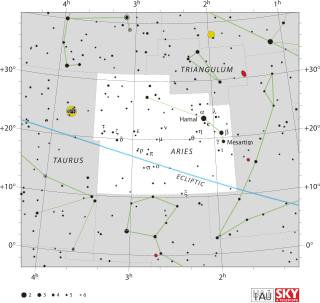
Aries is one of the constellations of the zodiac. It is located in the Northern celestial hemisphere between Pisces to the west and Taurus to the east. The name Aries is Latin for ram. Its old astronomical symbol is (♈︎). It is one of the 48 constellations described by the 2nd century astronomer Ptolemy, and remains one of the 88 modern constellations. It is a mid-sized constellation ranking 39th in overall size, with an area of 441 square degrees.

Meteor Crater or Barringer Crater is a meteorite impact crater about 37 mi (60 km) east of Flagstaff and 18 mi (29 km) west of Winslow in the desert of northern Arizona, United States. The site had several earlier names, and fragments of the meteorite are officially called the Canyon Diablo Meteorite, after the adjacent Cañon Diablo.

A meteoroid is a small rocky or metallic body in outer space. Meteoroids are distinguished as objects significantly smaller than asteroids, ranging in size from grains to objects up to a meter wide. Objects smaller than meteoroids are classified as micrometeoroids or space dust. Most are fragments from comets or asteroids, whereas others are collision impact debris ejected from bodies such as the Moon or Mars.

A meteor shower is a celestial event in which a number of meteors are observed to radiate, or originate, from one point in the night sky. These meteors are caused by streams of cosmic debris called meteoroids entering Earth's atmosphere at extremely high speeds on parallel trajectories. Most meteors are smaller than a grain of sand, so almost all of them disintegrate and never hit the Earth's surface. Very intense or unusual meteor showers are known as meteor outbursts and meteor storms, which produce at least 1,000 meteors an hour, most notably from the Leonids. The Meteor Data Centre lists over 900 suspected meteor showers of which about 100 are well established. Several organizations point to viewing opportunities on the Internet. NASA maintains a daily map of active meteor showers.

The Perseids are a prolific meteor shower associated with the comet Swift–Tuttle. The meteors are called the Perseids because they appear from the general direction of the constellation Perseus and in more modern times have a radiant bordering on Cassiopeia and Camelopardalis.
The Quadrantids (QUA) are a meteor shower that peaks in early January and whose radiant lies in the constellation Boötes. The zenithal hourly rate (ZHR) of this shower can be as high as that of two other reliably rich meteor showers, the Perseids in August and the Geminids in December, yet Quadrantid meteors are not seen as often as those of the two other showers because the time frame of the peak is exceedingly narrow, sometimes lasting only hours. Moreover, the meteors are quite faint, with mean apparent magnitudes between 3.0 and 6.0.

Annie Jump Cannon was an American astronomer whose cataloging work was instrumental in the development of contemporary stellar classification. With Edward C. Pickering, she is credited with the creation of the Harvard Classification Scheme, which was the first serious attempt to organize and classify stars based on their temperatures and spectral types. She was nearly deaf throughout her career after 1893, as a result of scarlet fever. She was a suffragist and a member of the National Women's Party.

The American Association of Variable Star Observers (AAVSO) is an international nonprofit organization. Founded in 1911, the organization focuses on coordinating, analyzing, publishing, and archiving variable star observations made largely by amateur astronomers. The AAVSO creates records that establish light curves depicting the variation in brightness of a star over time. The AAVSO makes these records available to professional astronomers, researchers, and educators.
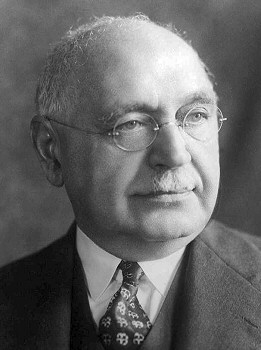
Frank Schlesinger was an American astronomer. His work concentrated on using photographic plates rather than direct visual studies for astronomical research.
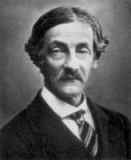
Alexander Stewart Herschel, DCL, FRS was a British astronomer.
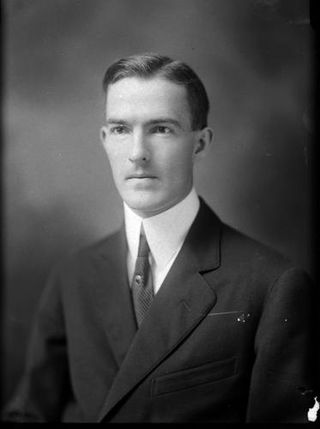
Charles Pollard Olivier was an American astronomer, notable for his contributions to the study of meteors, double stars and variable stars.

Claims of the existence of other moons of Earth—that is, of one or more natural satellites with relatively stable orbits of Earth, other than the Moon—have existed for some time. Several candidates have been proposed, but none have been confirmed. Since the 19th century, scientists have made genuine searches for more moons, but the possibility has also been the subject of a number of dubious non-scientific speculations as well as a number of likely hoaxes.

On February 9, 1913, a significant meteoric phenomenon was reported from locations across Canada, northeastern United States, Bermuda, and from many ships at sea as far south as Brazil, giving a total recorded ground track of over 11,000 km, and becoming known as the Great Meteor Procession of 1913. The meteors were particularly unusual in that there was no apparent radiant, the point in the sky from which meteors usually appear to originate. The observations were analysed in detail, later the same year, by the astronomer Clarence Chant, leading him to conclude that as all accounts were positioned along a great circle arc, the source had been a small, short-lived natural satellite of the Earth.
The Janssen Medal is an astrophysics award presented by the French Academy of Sciences to those who have made advances in this area of science.
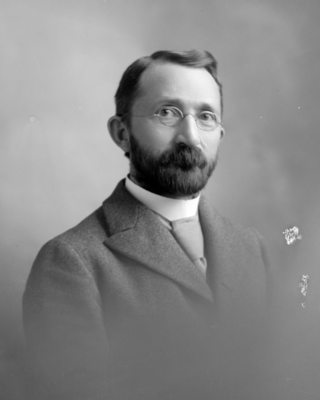
Herbert Alonzo Howe was an American astronomer and educator.
Alice Grace Cook (18 February 1877 - 27 May 1958), known as Grace Cook or A. Grace Cook was a British astronomer. Cook lived in Stowmarket, Suffolk. After she died she was remembered by her colleagues as a skilled and dedicated observer. In September 2021 it was announced that a new school in the town was to be named after Grace Cook. The school will be run by the Orwell Multi Academy Trust. In March 2023 minor planet 2000 EY156 was named Gracecook in her honour.
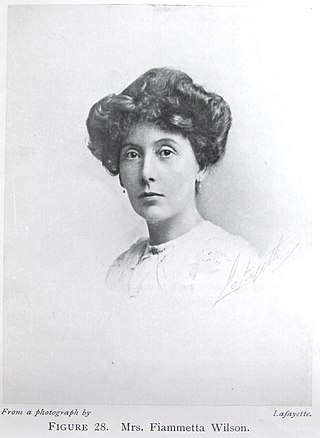
Fiammetta Wilson was a British astronomer elected a fellow of the Royal Astronomical Society in 1916.

The Valz Prize(Prix Valz) was awarded by the French Academy of Sciences, from 1877 through 1970, to honor advances in astronomy.

Frank Parkhurst Brackett was an American professor of astronomy who taught at Pomona College.

The Observatorio Manuel Foster, or Manuel Foster Observatory, is an astronomical observatory constructed on Cerro San Cristóbal near Santiago, Chile in 1903. This site was originally known as the D. O. Mills Observatory after the philanthropist Darius Ogden Mills. It was built as an offshoot of the Lick Observatory to observe stars in the southern hemisphere, and, under the direction of the American astronomer W. W. Campbell, was used in an extensive project to determine the apex of the Sun's motion through space.
References
- ↑ "American Meteor Society(AMS)". AllBusiness.com, Inc. 2009. Retrieved 2009-09-20.
- ↑ Olivier, Charles P. (February 1913). "Report of the American Meteor Society". Popular Astronomy . 21: 89–91. Bibcode:1913PA.....21...89O . Retrieved 2009-09-20.
- ↑ Olivier, Charles P. (September 1912). "The eta Aquarid meteors". Astronomical Journal. 27 (639–640): 129–130. Bibcode:1912AJ.....27..129O. doi: 10.1086/103976 .
- ↑ Olivier, Charles P. (1926). "Meteor notes". Popular Astronomy. 34: 642. Bibcode:1926PA.....34..642O . Retrieved 2009-09-20.
- ↑ Olivier, Charles P. (1951). "Meteor notes from the American Meteor Society". Popular Astronomy. 59: 443. Bibcode:1951PA.....59Q.443O . Retrieved 2009-09-20.
- ↑ Pruett, J. Hugh (April 1939). "Far Western Activities of the American Meteor Society". Publications of the Astronomical Society of the Pacific. 51 (300): 99–104. Bibcode:1939PASP...51...99P. doi:10.1086/125012.
- ↑ Olivier, Charles P. (1965). "Second Catalog of Hourly Meteor Rates". Smithsonian Contributions to Astrophysics . 8 (6): 171–180. Bibcode:1965SCoA....8..171O. doi:10.5479/si.00810231.8-6.171 . Retrieved 2009-09-20.
- ↑ Hall, Cathy L. (February 2000). "For the Love of Meteors". Journal of the Royal Astronomical Society of Canada . 94: 9–13. Bibcode:2000JRASC..94....9H . Retrieved 2009-09-20.
- ↑ Richardson, Jim (1999). "Recent changes to the American Meteor Society staff". Archived from the original on 2011-07-16. Retrieved 2009-09-20.
